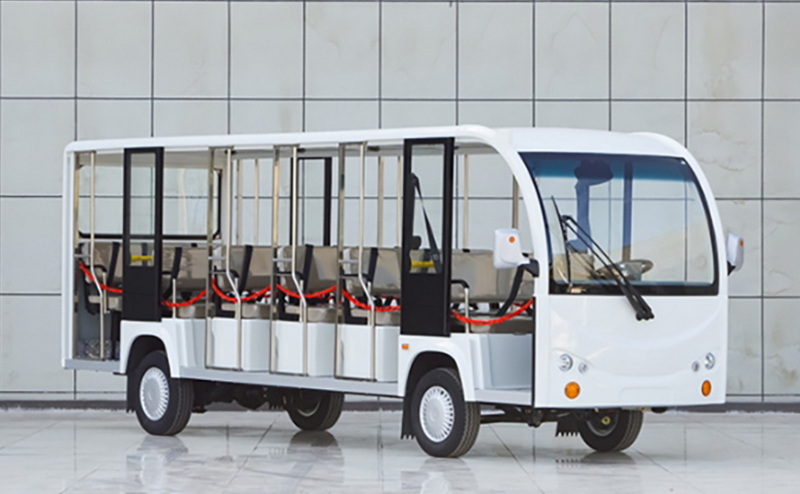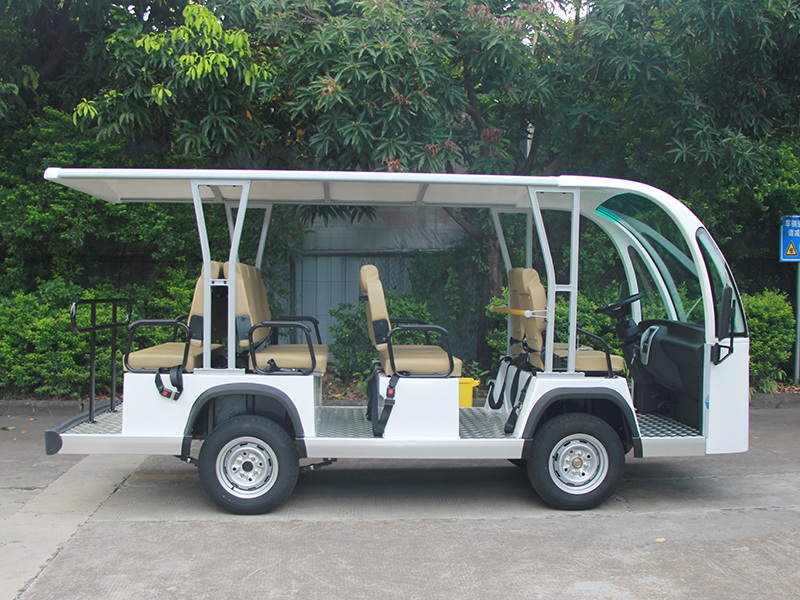Content Menu
● The Rise of China Electric Sightseeing Cars
● Key Factors Driving China Electric Sightseeing Cars' Global Dominance
>> 1. Government Support and Strategic Policies
>> 2. Advanced Technology and Innovation
>> 3. Cost Competitiveness and Affordability
>> 4. Robust Domestic Market and Export Growth
>> 5. Environmental and Social Trends
>> 6. Customization and Versatility
● Market Outlook and Future Trends
● Conclusion
● FAQ: China Electric Sightseeing Cars
>> 1. What makes China electric sightseeing cars more affordable than others?
>> 2. How do government policies in China support electric sightseeing cars?
>> 3. Are China electric sightseeing cars exported internationally?
>> 4. What technological innovations are featured in China electric sightseeing cars?
>> 5. How do electric sightseeing cars contribute to environmental sustainability?
China electric sightseeing cars have rapidly emerged as a dominant force in the global market, reshaping the landscape of electric mobility in tourism and urban transport. This article explores the multifaceted reasons behind their global dominance, covering government policies, technological innovation, market dynamics, and international expansion. Rich with insights, the article also concludes with a FAQ section addressing common queries about this booming industry.

The Rise of China Electric Sightseeing Cars
China's electric vehicle (EV) industry has experienced explosive growth, with electric car sales surpassing 17 million globally in 2024, half of which were in China alone. Among various EV segments, electric sightseeing cars-small, eco-friendly vehicles used in tourist sites, parks, and urban sightseeing-have become a significant part of this success story. These vehicles are designed to provide a quiet, emission-free, and comfortable way for tourists and city dwellers to explore their surroundings, making them ideal for environmentally sensitive areas and urban centers.
The rapid urbanization and booming tourism industry in China have created a fertile ground for the development and adoption of electric sightseeing cars. Cities and tourist destinations are increasingly prioritizing sustainable transport solutions to reduce pollution and improve visitor experiences. This domestic demand has propelled Chinese manufacturers to innovate and scale production, enabling them to compete effectively on the global stage.
Key Factors Driving China Electric Sightseeing Cars' Global Dominance
1. Government Support and Strategic Policies
China's government has played a pivotal role in accelerating the adoption and production of electric sightseeing cars through a comprehensive set of policies:
- Subsidies and Incentives: The Chinese government offers substantial financial incentives for new energy vehicles (NEVs), including electric sightseeing cars. These subsidies reduce the upfront cost for manufacturers and consumers, making electric vehicles more accessible.
- Infrastructure Investment: China has invested heavily in charging infrastructure, including fast-charging stations and battery swapping facilities. This network supports the practical use of electric sightseeing cars in urban and tourist areas.
- Environmental Regulations: Strict emissions standards and urban pollution control policies compel cities to replace traditional fuel-powered vehicles with electric alternatives.
- Urban Electrification Goals: Major cities such as Beijing, Shanghai, and Shenzhen have set ambitious targets to electrify their taxi and ride-hailing fleets by 2025, creating a large captive market for electric sightseeing vehicles.
These policies have created a robust ecosystem that encourages innovation, production, and adoption of electric sightseeing cars, positioning China as a leader in this sector.
2. Advanced Technology and Innovation
Chinese manufacturers have invested heavily in research and development, resulting in significant technological advancements that enhance the appeal and functionality of electric sightseeing cars:
- Battery Technology: Leading companies have developed high-efficiency lithium-ion batteries that offer extended range, faster charging times, and improved safety. Some manufacturers are also exploring solid-state batteries for even better performance.
- Lightweight and Durable Design: Electric sightseeing cars are engineered with lightweight materials such as aluminum alloys and composites, improving energy efficiency and durability, which is critical for frequent stop-and-go use in sightseeing applications.
- Smart Connectivity: Many China electric sightseeing cars come equipped with smart features, including GPS navigation, real-time monitoring, and mobile app integration, enhancing the user experience for operators and passengers.
- Autonomous Driving Capabilities: Some models incorporate autonomous or semi-autonomous driving technology, allowing for safer and more efficient operation in controlled environments such as parks and tourist zones.
These innovations not only improve vehicle performance but also provide a competitive edge in the global market.
3. Cost Competitiveness and Affordability
One of the most compelling reasons for the global dominance of China electric sightseeing cars is their affordability. Several factors contribute to this cost advantage:
- Economies of Scale: China's massive domestic market enables manufacturers to produce electric sightseeing cars in large volumes, significantly reducing per-unit costs.
- Local Supply Chains: The availability of local suppliers for batteries, electric motors, and other components reduces dependency on expensive imports.
- Government Subsidies: Subsidies and tax incentives lower the purchase price for operators, making electric sightseeing cars financially attractive.
- Efficient Manufacturing: Advanced manufacturing techniques and automation in Chinese factories further reduce production costs.
This affordability allows Chinese electric sightseeing cars to penetrate price-sensitive markets in Asia, Latin America, Africa, and even parts of Europe, where cost remains a critical factor for adoption.
4. Robust Domestic Market and Export Growth
China's domestic market for electric sightseeing cars is the largest worldwide, accounting for nearly half of all new energy vehicle sales in 2024. This strong home base supports:
- Continuous Product Development: Intense competition among domestic manufacturers drives ongoing innovation and quality improvements.
- Export Expansion: Chinese companies are actively expanding their presence overseas, exporting electric sightseeing cars to Southeast Asia, Europe, the Middle East, and Africa. These exports are supported by competitive pricing, reliable technology, and growing global demand for sustainable transport solutions.
- Trade Partnerships: China has established trade agreements and partnerships that facilitate smoother export processes and market entry for its electric sightseeing cars.
The combination of a large domestic market and growing international demand ensures sustained growth and global influence.

5. Environmental and Social Trends
Global awareness of climate change and urban air quality issues has heightened demand for zero-emission vehicles. Electric sightseeing cars contribute to environmental sustainability by:
- Reducing Carbon Emissions: They produce zero tailpipe emissions, helping cities and tourist destinations lower their carbon footprint.
- Lowering Noise Pollution: Electric vehicles operate quietly, improving the ambiance in natural parks, historic sites, and urban centers.
- Promoting Green Tourism: Many tourist destinations are adopting electric sightseeing cars as part of their commitment to eco-friendly tourism, enhancing their appeal to environmentally conscious travelers.
- Improving Public Health: By replacing internal combustion engine vehicles, electric sightseeing cars help reduce air pollutants that contribute to respiratory and cardiovascular diseases.
These social and environmental benefits reinforce the global appeal of China electric sightseeing cars and align with international sustainability goals.
6. Customization and Versatility
Chinese manufacturers offer a wide range of electric sightseeing car models tailored to different environments and customer needs:
- Variety of Sizes: From small two-seaters for intimate tours to larger multi-passenger vehicles for group sightseeing.
- Custom Features: Options such as open-air designs, canopy roofs, all-terrain tires, and luxury interiors cater to diverse market segments.
- Adaptability: Vehicles can be customized for specific uses, including golf carts, airport shuttles, resort transports, and city tours.
This versatility allows China electric sightseeing cars to serve a broad spectrum of applications worldwide, further boosting their market penetration.
Market Outlook and Future Trends
The global electric vehicle market is projected to exceed 20 million units by 2025, with China maintaining its leadership position. The electric sightseeing car segment is expected to grow in tandem, driven by:
- Expansion of Tourism Infrastructure: As more countries develop sustainable tourism facilities, demand for electric sightseeing cars will increase.
- Technological Breakthroughs: Continued improvements in battery technology, autonomous driving, and vehicle connectivity will enhance the attractiveness of these vehicles.
- Urban Policy Support: Increasing urban policies favoring electric mobility solutions will encourage wider adoption in city centers and tourist hotspots.
- International Collaboration: Partnerships between Chinese manufacturers and foreign companies will facilitate technology transfer and market expansion.
China electric sightseeing cars are poised to remain at the forefront of this growth, setting standards for quality, affordability, and sustainability.
Conclusion
China electric sightseeing cars dominate the global market due to a combination of strong government backing, technological innovation, cost advantages, and a vast domestic market that fuels continuous improvement and export growth. This dominance not only supports China's environmental goals but also offers a scalable model for sustainable tourism and urban mobility worldwide. As the global demand for electric vehicles surges, China's leadership in electric sightseeing cars is set to deepen, shaping the future of eco-friendly transportation.

FAQ: China Electric Sightseeing Cars
1. What makes China electric sightseeing cars more affordable than others?
China's large-scale production, local supply chains, and government subsidies significantly reduce manufacturing and purchase costs, making these vehicles more affordable globally.
2. How do government policies in China support electric sightseeing cars?
The Chinese government provides subsidies, invests in charging infrastructure, enforces strict emissions standards, and promotes electrification of urban fleets, creating a favorable ecosystem for electric sightseeing cars.
3. Are China electric sightseeing cars exported internationally?
Yes, China exports electric sightseeing cars to Southeast Asia, Europe, and other emerging markets, leveraging cost advantages and growing global demand despite some tariff barriers.
4. What technological innovations are featured in China electric sightseeing cars?
Innovations include advanced lithium-ion batteries, lightweight vehicle design, smart connectivity, and autonomous driving capabilities tailored for sightseeing and urban use.
5. How do electric sightseeing cars contribute to environmental sustainability?
They produce zero tailpipe emissions, reduce noise pollution, and help cities and tourist areas lower their carbon footprint, aligning with global climate goals.










































